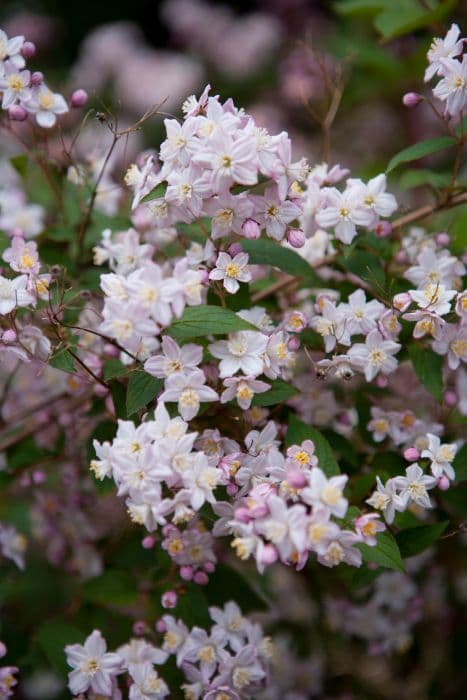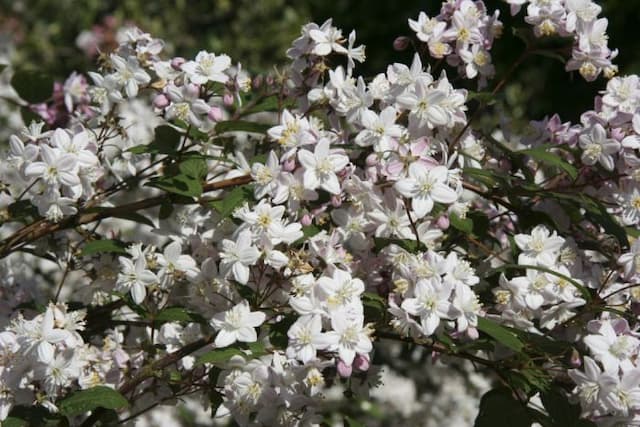Hydrangea Hydrangea macrophylla Magical Wings = 'Hortmawin' (PBR) (Magical Series) (H)

ABOUT
The Hydrangea Magical Wings, which is part of the Magical Series, showcases a stunning display of large, rounded flower heads that can change color with the soil pH—ranging from a vivid pink to a deep blue. The blooms have a distinctive, frilly appearance that is accentuated by a multitude of smaller, star-shaped flowers packed closely together, giving them a lush, full look. Over time, the flowers mature and may acquire a vintage hue with touches of green, cream, or purple, adding a layer of visual interest as the seasons change. This decidirectional plant has dark green, glossy leaves that provide a striking backdrop for the colorful blooms, creating a fresh and vibrant look throughout its blooming season. The Magical Wings Hydrangea has a bushy, robust habit with sturdy stems that hold the flower heads upright, ensuring that the impressive blooms are always on full display.
About this plant
 Names
NamesFamily
Hydrangeaceae.
Synonyms
Bigleaf Hydrangea, French Hydrangea, Lacecap Hydrangea, Mophead Hydrangea, Penny Mac, Hortensia.
Common names
Hydrangea macrophylla 'Hortmawin'
 Toxicity
ToxicityTo humans
Hydrangeas, including the variety Hydrangea macrophylla, are known to contain cyanogenic glycosides, which can release cyanide when chewed or digested. While serious poisonings are rare, ingestion of parts of the plant can lead to symptoms like nausea, vomiting, and diarrhea. In larger quantities, more severe symptoms such as dizziness, headache, and confusion could occur. It is generally advised to avoid eating any part of hydrangeas and to seek medical attention if ingestion occurs.
To pets
Hydrangeas, including the variety Hydrangea macrophylla, are toxic to pets due to the presence of cyanogenic glycosides. These compounds can release cyanide when the plant material is chewed or broken down in the stomach. If a pet ingests any part of a hydrangea, it may exhibit symptoms such as vomiting, diarrhea, lethargy, and abdominal pain. In severe cases, ingestion can lead to more serious effects including depression, cyanosis, and hyperventilation. If you suspect your pet has eaten hydrangea, it is important to contact a veterinarian as soon as possible.
 Characteristics
CharacteristicsLife cycle
Perennials
Foliage type
Deciduous
Color of leaves
Varies
Flower color
Varies
Height
3-5 feet (0.91-1.52 meters)
Spread
3-5 feet (0.91-1.52 meters)
Plant type
Shrub
Hardiness zones
5-9
Native area
Japan
Benefits
 General Benefits
General Benefits- Ornamental Appeal: Hydrangea macrophylla Magical Wings boasts large, showy blooms that add aesthetic value to gardens and landscapes.
- Long Blooming Season: It flowers from early summer to late fall, providing a prolonged period of visual interest.
- Versatility in Landscaping: Suitable for borders, hedging, or as a focal point in garden designs. Also does well in containers for patios or balcony gardens.
- Attracts Pollinators: The flowers attract bees and butterflies, supporting local ecosystems and promoting biodiversity.
- Color Variation: The bloom color can change from pink to blue depending on soil pH, offering gardeners an opportunity to experiment with and alter their garden palette.
- Low Maintenance: Once established, it requires minimal care beyond occasional pruning and watering, making it a good choice for busy gardeners.
- Seasonal Interest: In addition to summer blooms, this hydrangea can provide attractive foliage and dried flower heads for autumn and winter interest.
- Emotional Wellbeing: Its vibrant blooms and lush foliage can help to create a peaceful, tranquil environment, contributing to emotional and psychological wellbeing.
 Medical Properties
Medical PropertiesThis plant is not used for medical purposes.
 Air-purifying Qualities
Air-purifying QualitiesThis plant is not specifically known for air purifying qualities.
 Other Uses
Other Uses- Hydrangeas can be used in photography and art to create aesthetic compositions, with their vibrant colors and full blooms providing a striking visual element.
- Pressed hydrangea flowers make for beautiful bookmarks or decorative paper enhancements, preserving their color and shape for crafting purposes.
- The wood of hydrangeas is sometimes used to make small intricate carvings or inlay work, taking advantage of its fine grain.
- Dried hydrangea blooms can be used to create natural dyes for fabrics, offering a range of colors depending on the soil pH they were grown in.
- Due to their bulky flowerheads, hydrangeas are used in floral arrangements to create volume and structure, often serving as the centerpiece in bouquets.
- Hydrangeas can be utilized in scale modeling to represent bushes or trees, adding realism to miniature landscapes or dioramas.
- In some cultures, hydrangeas are considered symbols of gratitude or apology, and are thus given as presents in specific social contexts.
- The large leaves of hydrangeas can be used as natural wraps for small delicate items or as a unique decorative plating for presenting culinary dishes.
- Dried hydrangea petals can be incorporated into homemade potpourri mixes, combining their subtle fragrance with other herbs and spices.
- In certain festivals or parades, hydrangea blossoms might be used as natural confetti or as part of garlands and decorations.
Interesting Facts
 Feng Shui
Feng ShuiThe Hydrangea is not used in Feng Shui practice.
 Zodiac Sign Compitability
Zodiac Sign CompitabilityThe Hydrangea is not used in astrology practice.
 Plant Symbolism
Plant Symbolism- Understanding: The hydrangea is often associated with heartfelt emotions and can symbolize an understanding between people.
- Gratitude: With its bountiful blooms, a hydrangea can also represent gratitude and thanksgiving, often given as gifts to express thanks.
- Apology: In Japan, hydrangeas can signify an apology or a symbol of regret, as they were historically used to convey these messages.
- Frigidity and Heartlessness: Due to some of its historical use in certain cultures, hydrangeas sometimes carry a negative connotation of frigidity or heartlessness.
- Abundance: The lavish round shape and numerous flowers of hydrangeas symbolize abundance and prosperity.
- Beauty: The hydrangea's lush and attractive flowers often represent beauty and grace.
 Water
WaterThe Bigleaf Hydrangea requires consistent moisture and should be watered deeply once a week, but the frequency may need to increase during hot or dry periods to maintain soil moisture. An adequate amount is typically around 1 gallon of water for smaller plants and up to 2.5 gallons for larger, established shrubs each time you water. It's important to avoid overhead watering to reduce the risk of leaf diseases and ensure the water is applied directly to the soil around the base of the plant. During the winter, reduce watering but do not allow the roots to dry out completely.
 Light
LightBigleaf Hydrangeas prefer dappled sunlight or morning sun with afternoon shade. They thrive in a spot that protects them from the harsh afternoon sun, especially in southern regions. For optimal growth and bloom, situate your hydrangea where it can receive a few hours of gentle sunlight each day, such as on the east side of a building or under the light shade of a tree canopy.
 Temperature
TemperatureBigleaf Hydrangeas grow best when the temperature is between 60°F and 75°F. They can tolerate a minimum temperature of 50°F, but frost can damage new growth, and maximum temperatures that exceed 85°F for extended periods can stress the plant. It's important to protect hydrangeas from extreme cold by providing winter mulch and from extreme heat by ensuring adequate hydration and shade.
 Pruning
PruningBigleaf Hydrangeas should be pruned to maintain shape and remove dead or old wood, which promotes new growth and better blooms. Pruning is best done immediately after flowering since they bloom on old wood; late winter or early spring pruning can remove flower buds. A general guideline is to cut back the flowering stems by one third once the blooms have faded.
 Cleaning
CleaningAs needed
 Soil
SoilBigleaf Hydrangea thrives best in well-draining, rich, loamy soil with a pH of about 5.5 for blue flowers or 6.5 for pink, amended with organic matter.
 Repotting
RepottingBigleaf Hydrangeas should generally be repotted every 2-3 years to replenish the soil and provide room for growth.
 Humidity & Misting
Humidity & MistingBigleaf Hydrangea prefers high humidity levels, ideally between 50-60% for optimal growth.
 Suitable locations
Suitable locationsIndoor
Place in bright, indirect light; keep soil moist.
Outdoor
Plant in partial shade, shelter from strong winds.
Hardiness zone
6-9 USDA.
 Life cycle
Life cycleThe life cycle of Hydrangea macrophylla, commonly known as the Bigleaf Hydrangea or Magical Wings, begins with seed germination, which requires moist, fertile soil and warm temperatures. Following germination, seedlings develop into juvenile plants with foliage and a root system established over several weeks to months. As the plant matures, it enters a vegetative state where it grows larger and stronger, forming the characteristic large, green leaves and sturdy stems. The Bigleaf Hydrangea then enters the flowering stage, producing large, showy flower heads that can vary in color based on soil pH and typically bloom in late spring to early summer. After pollination, seeds form and the plant eventually goes dormant in the fall or winter, reducing growth and conserving energy. The cycle restarts the following spring when temperatures rise and daylight increases, signaling the plant to resume growth and prepare for another flowering season.
 Propogation
PropogationPropogation time
Spring to Summer
Propogation: The most popular method of propagation for the Hydrangea macrophylla, commonly known as 'Magical Wings', is through semi-hardwood cuttings. This process typically begins in late summer when the stems of the plant have matured yet still retain some flexibility. To execute this method, gardeners cut a section of stem about 4 to 6 inches (approximately 10 to 15 centimeters) long with several leaves attached. The lower leaves are removed and the cut end is treated with a rooting hormone to encourage root development. The cutting is then placed in a well-draining rooting medium such as a mix of peat and perlite. It's essential to maintain high humidity around the cutting by covering it with a plastic bag or placing it in a propagation chamber. Roots generally develop within a few weeks to a couple of months, after which the new hydrangea plantlet can be transitioned to a larger pot or directly planted in the garden.








![Hydrangea [Early Sensation]](/_next/image?url=https%3A%2F%2Fplants-admin.emdemapps.com%2Fimages%2Fplants%2F%2Fimages%2F604b6150338db.png&w=640&q=75)
